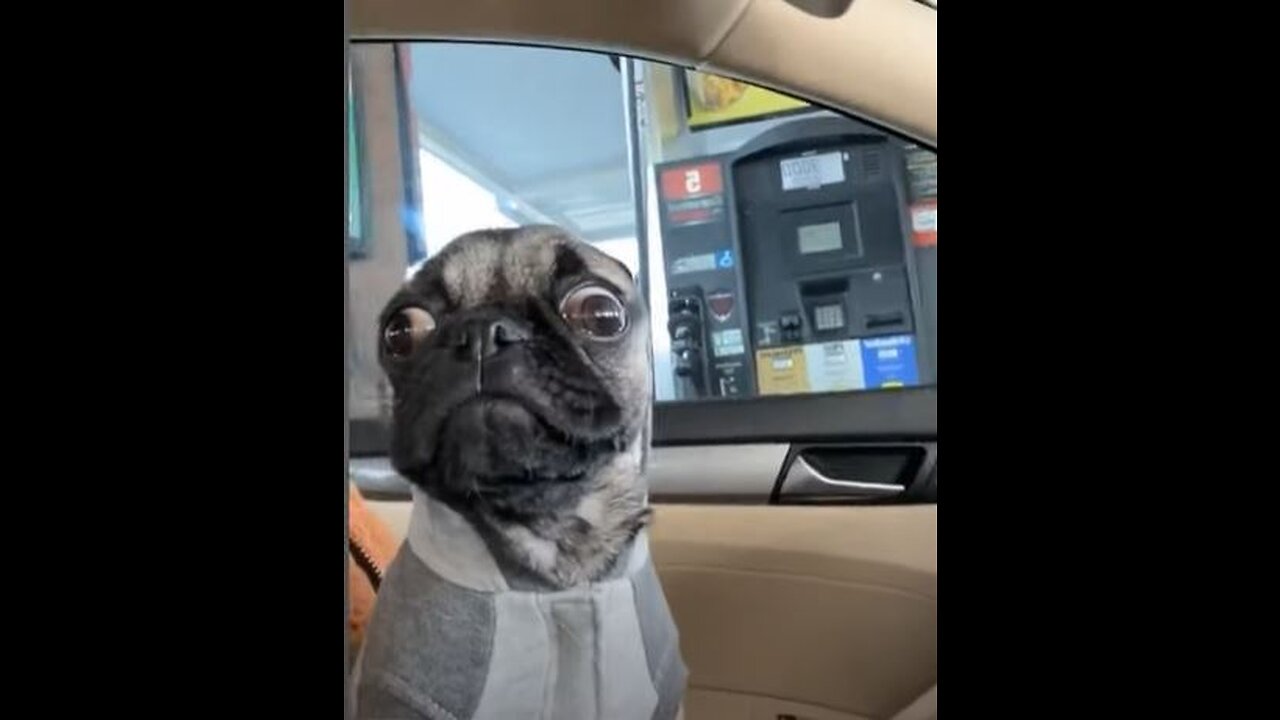Premium Only Content

Pug Funny Moments - Cute Dog Videos | Pets Funny
The Latin phrase multum in parvo – meaning “much in little” – is often used to describe Pugs. Why? Because this charming, playful, people-loving breed is a lot of dog crammed into a small body. Pugs are expressive, funny, loyal, and sweet. To know a Pug is to adore one.
Basic Pug Facts
Pugs belong to the companion classification of dogs. Despite their stocky, muscular build, they are part of the toy group. Fully grown, these pups are 10 to 12 inches tall and weigh between 14 and 20 pounds. The average Pug life span is 12 to 15 years. With their gentle, playful personalities and sturdy bodies, Pugs make great canine companions for families with small children.
symptoms of Cushing’s disease in dogs _ brindle greyhound dog resting on grass
Breed History
Pugs are one of the oldest dog breeds around. Some enthusiasts claim they can be traced all the way back to the Shang Dynasty, which ruled China from 1600-1046 B.C. While Pugs did originate in China, most people agree that it was likely closer to 400 B.C. – which is still quite impressive!
They were considered to be good luck because their forehead wrinkles resembled the Chinese character for “prince.” Emperors kept Pugs as lapdogs, and they were often guarded by their own soldiers and even given small castles.
Top 6 Historical Pug Facts
A lot happened between 400 B.C. and the 19th century when the breed finally made it to the United States. Here are some of the highlights:
In ancient times, Pugs kept Tibetan monks company in their monasteries.
Portuguese traders brought the breed to Holland in the 16th century.
In the Netherlands in 1572, a Pug named Pompey famously saved his famous pet parent – William the Silent, Prince of Orange – from Spanish assassins by barking to wake his master.
In 1688, William III and Mary introduced Pugs to England when they arrived to claim the throne.
Josephine Bonaparte, Napoleon’s wife, used her Pug to deliver messages to her family while she was imprisoned.
In the early 19th century, Queen Victoria popularized the breed. She dearly loved her many Pugs, including Olga, Pedro, Minka, Fatima, and Venus.
What’s in a Name?
No one is certain where the name Pug originated. Some think it comes from the Latin pugnus, meaning “fist,” because the Pug’s sweet, smooshed profile resembles a human fist. Another theory is that Pugs were named after “pug monkeys,” a term of endearment used for marmosets – they were frequently kept as pets in the 18th century and have a similar facial structure. Still others speculate that the name evolved from Puck, the mischievous fairy from "A Midsummer Night's Dream."
symptoms of Cushing’s disease in dogs _ brindle greyhound dog resting on grass
Attributes
Pugs are an incredibly distinct breed in terms of appearance. These shorthaired dogs have a sleek, double-layered coat that comes in a variety of colors, including black, fawn, silver fawn, and apricot.
Pugs are square and thickset with round, flat faces, deep wrinkles, large dark eyes, and velvety ears. They have moles called “beauty spots” on their cheeks, a thumbprint-shaped mark on their forehead, and a black trace that runs down their back.
Pugs also have a classic underbite, which gives them a comical, faux-grumpy expression. An underbite might not cause any problems, but can be an issue if it interferes with the dog’s ability to eat or causes injury to the soft tissues in the mouth. In this case, your veterinarian might recommend orthodontic treatment.
Pug Temperament
In terms of personality, you couldn’t ask for a more likable pup. Pugs are incredibly friendly people pleasers who have a great sense of humor and love showing off. They even seem to enjoy being dressed in adorable costumes. Pugs have a serious side, too. They are very affectionate and intuitive to their pet parents’ emotions. If left alone for long periods of time, Pugs can get anxious or depressed.
Although they’re small, Pugs can be dependable watchdogs. They are welcoming to strangers when their pet parents approve, but they still know how to guard their castle. Pugs aren’t “yappy” dogs and are fairly inactive, which makes them great for apartment dwellers. Although what they lack in yapping, they make up for in other sounds…like wheezing, snorting, and snoring!
-
 LIVE
LIVE
I_Came_With_Fire_Podcast
2 hours agoThey Just Built the Amazon of Crypto And It’s Fully Decentralized
109 watching -
 55:08
55:08
LFA TV
8 hours agoPeace Derangement Syndrome | TRUMPET DAILY 5.20.25 7PM
6.53K1 -
 1:21:56
1:21:56
Dr. Drew
6 hours ago14 Years & 19 Meds: Why Laura Delano Stopped Years Of Psychiatric Drugs & Went "Unshrunk" + Paleovalley's Autumn Smith – Ask Dr. Drew
39.1K6 -
 LIVE
LIVE
LumpyPotatoX2
4 hours agoCyberPunk 2077 Gameplay + 1775 Coffee Partner - #RumbleGaming
97 watching -
 1:42:15
1:42:15
John Fredericks Media Network
9 hours agoJohn Fredericks Show 5/20/2025
47 -
 11:53
11:53
China Uncensored
3 hours agoI Knew China’s Military Was Overrated. India Just Proved It.
18.5K13 -
 LIVE
LIVE
Spartan (Pro Halo esports Player)
2 hours agoRanked then SWTOR
125 watching -
 15:27
15:27
T-SPLY
3 hours agoCongresswoman Charged With Assaulting DHS Officers Denies Everything!
18.5K14 -
 1:51:33
1:51:33
Redacted News
4 hours agoIsrael launches Gaza total DESTRUCTION operation "Gideon's Chariots", JD Vance cancels trip
131K108 -
 1:12:57
1:12:57
vivafrei
6 hours agoFAFO! Congresswoman LaMonica McIver ARRESTED & CHARGED! Canadian Election Fraud! AND MORE!
161K23